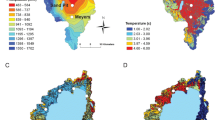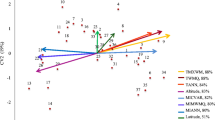Summary
Four populations of Abies concolor, white fir, were sampled along an elevational transect in the central Sierra Nevada mountains of California. This paper is based on data taken during the first two years' growth in a nearby nursery at Placerville, California. Ten of the thirteen growth, size, and needle morphological characteristics had significant differences between population samples, while eleven characteristics had significant differences between open-pollinated families within the population samples. High-elevation population samples were smaller in size and needle measurements, had fewer adaxial stomatal rows, blunter needle tips, and a shorter growing season. Most characteristic values were distributed ecotypically between the two lower- and the two higher-elevation population samples. Analyses of the patterns of variation demonstrated that characteristics of size and growth showed greater differentiation between population samples than did characteristics of needle morphology. It was concluded that the differences between characteristic patterns were caused by the more intense selection pressures acting upon the characteristics of size and growth. No consistent differences were discovered between these population samples in terms of total amounts of within-population genetic variation. The failure to find differences in intra-population variation may be due to the high rates of migration that probably exist within such a transect, and the fact that none of the populations included in this study are truly marginal. There were large differences between characteristics for total within-population variation; a positive but non-significant correlation was found between high coefficients of variation and those characteristics with much differentiation between populations. It is postulated that the maintenance of this intra-population variation was caused by microhabitat adaptations and gene flow. Evidence for increased genetic variation within open-pollinated families due to pollen immigration is presented, and its implications discussed.
Similar content being viewed by others
Literature
Allard, R.W.; Babbel, G.R.; Clegg, M.T.; Kahler, A.L.: Evidence for coadaptation in Avena barbata. Proc. Nat. Acad. Sci. 69, 3043–3048 (1972)
Barber, H.N.; Jackson, W.D.: Natural selection in action in Eucalyptus. Nature 179, 1267–1269 (1957)
Carson, H.L.: The genetic characteristics of marginal populations of Drosophila. Cold Spring Harbor Symp. Quant. Biol. 20, 276–287 (1955)
Carson, H.L.: Genetic conditions that promote or retard the formation of species. Cold Spring Harbor Symp. Quant. Biol. 24, 87–103 (1959)
Clausen, J.; Keck, D.D.; Hiesey, W.M.: Experimental studies on the nature of species. III. Environmental responses of climatic races of Achillea. Carnegie Institution of Washington Publication 581, 129 p. (1948)
Conkle, M.T.; Libby, W.J.; Hamrick, J.L.: Winter injury among white fir seedlings. Pacific Southwest Research Note 138, 6 p. (1966)
Critchfield, W.B.; Allenbaugh, G.L.: The distribution of Pinaceae in and near northern Nevada. Madrõno 20, 12–25 (1969)
Ehrlich, P.R.; Raven, P.H.: Differentiation of populations. Science 165, 1228–1232 (1969)
Fowells, H.A.: Silvics of forest trees of the United States. Agriculture Handbook No. 271. U.S. Department of Agriculture, Forest Service, 762 p. (1965)
Griffin, J.R.; Critchfield, W.B.: The distribution of forest trees in California. ISDA Forest Service Research Paper PSW 82, 114 p. (1972)
Hamrick, J.L.: Geographic variation in white fir. M.S. Thesis, University of California, Berkeley, 143 p. (1966)
Hamrick, J.L.; Allard, R.W.: Microgeographical variation in allozyme frequencies in Avena barbata. Proc. Nat. Acad. Sci. 69, 2100–2104 (1972)
Hamrick, J.L.; Libby, W.J.: Variation and selection in western montane species. I. White fir. Silvae Genetica 21, 29–35 (1972)
Koski, V.: A study of pollen dispersal as a mechanism of gene flow in conifers. Commun. Inst. Forest. Fenn. 70(4), 78 p. (1970)
Silen, R.R.: Pollen dispersal considerations for Douglas fir. J. Forestry 60, 790–795 (1962)
Soulé, M.: The epistasis cycle: A theory of marginal populations. Annual Rev. Ecology a. Systematics 4, 165–187 (1973)
Tigerstedt, P.M.A.: Studies on isozyme variation in marginal and central populations of Picea abies. Hereditas 75, 47–60 (1973)
Author information
Authors and Affiliations
Additional information
Communicated by W. J. Libby
Rights and permissions
About this article
Cite this article
Hamrick, J.L. Variation and selection in western montane species II. Variation within and between populations of white firon an elevational transect. Theoret. Appl. Genetics 47, 27–34 (1976). https://doi.org/10.1007/BF00277401
Received:
Issue Date:
DOI: https://doi.org/10.1007/BF00277401




